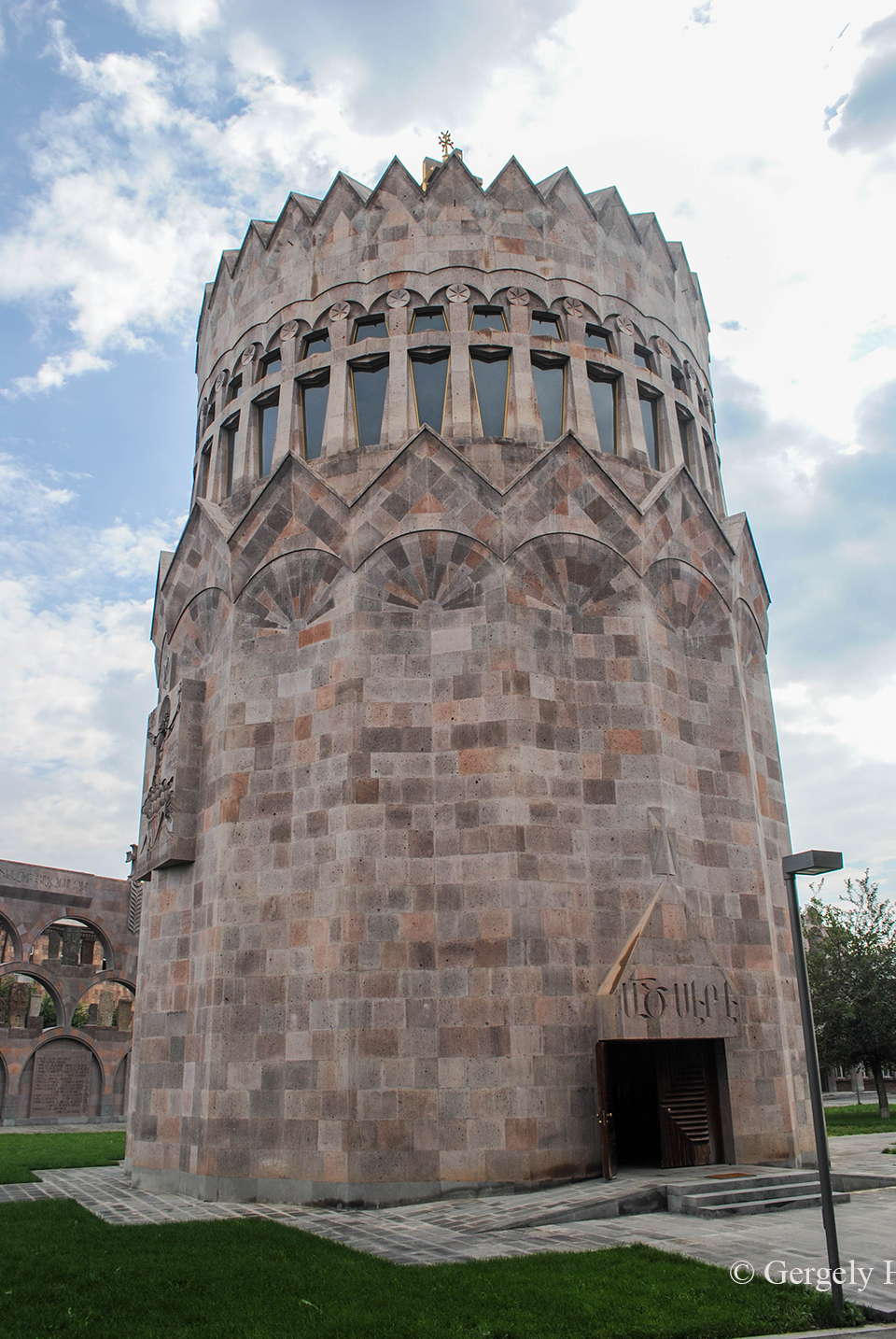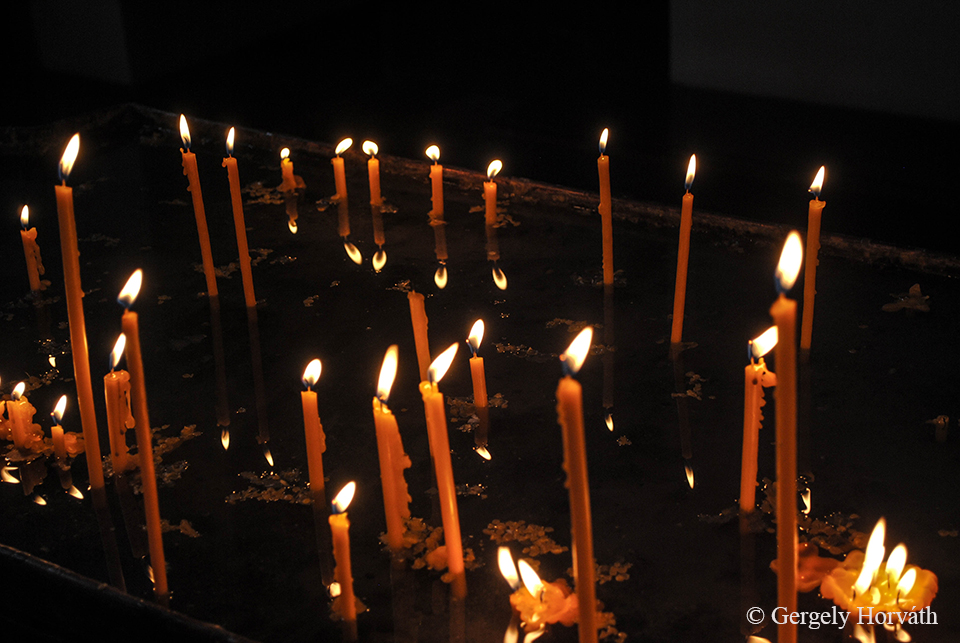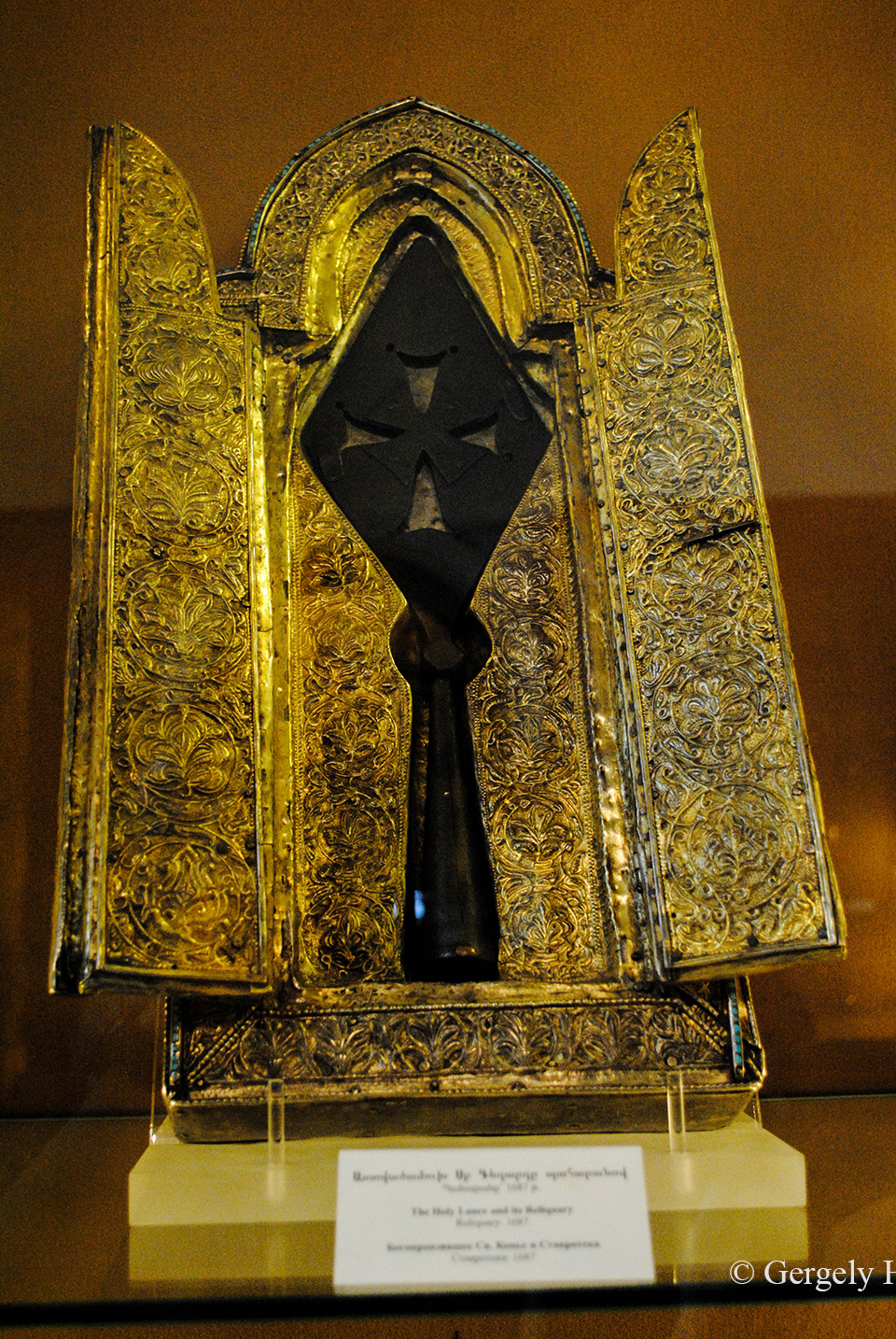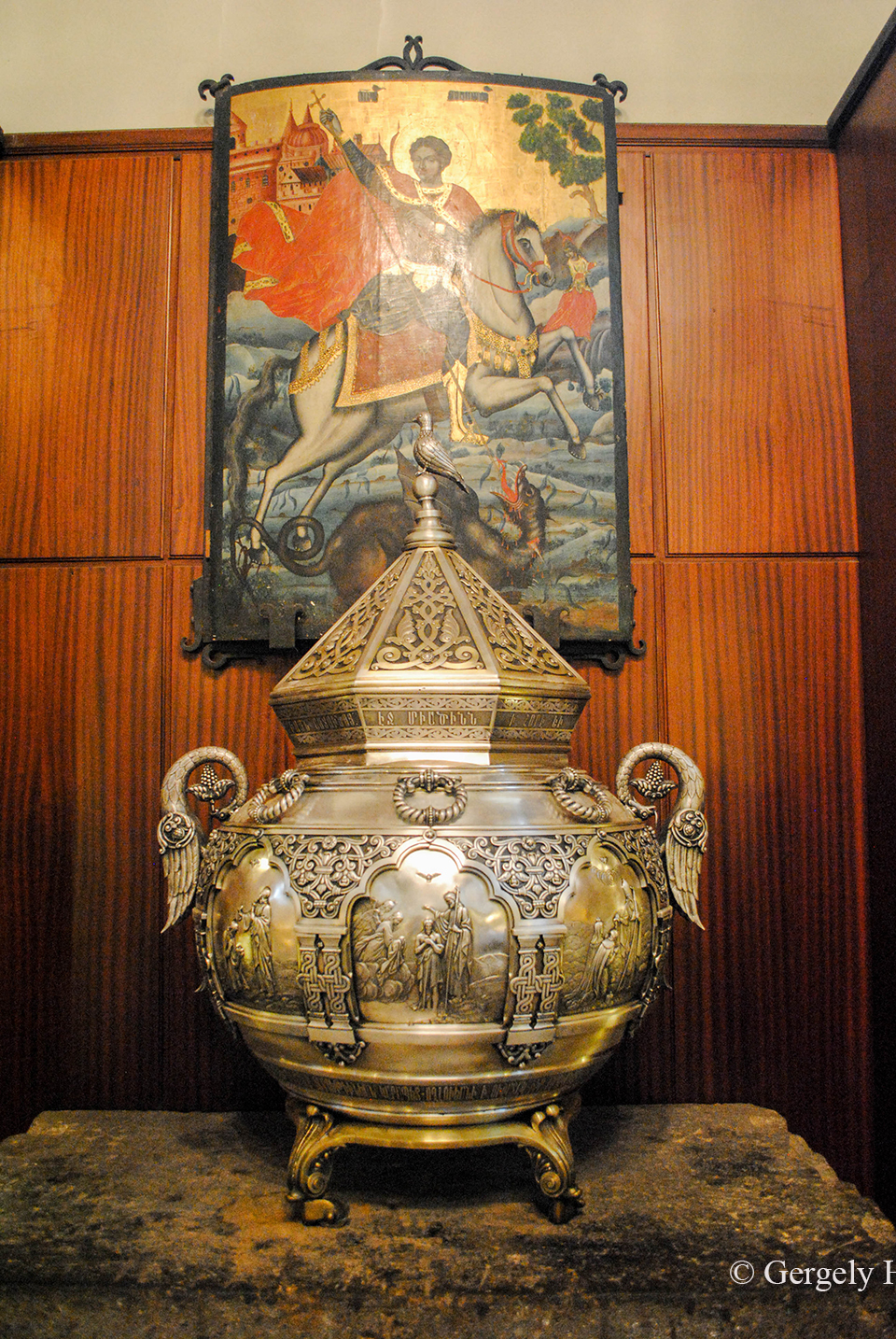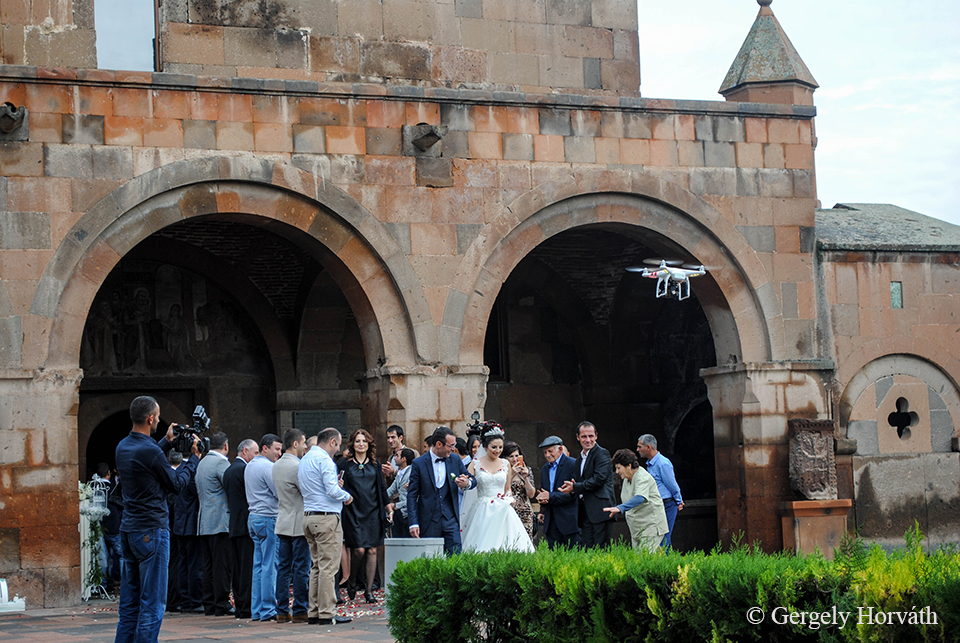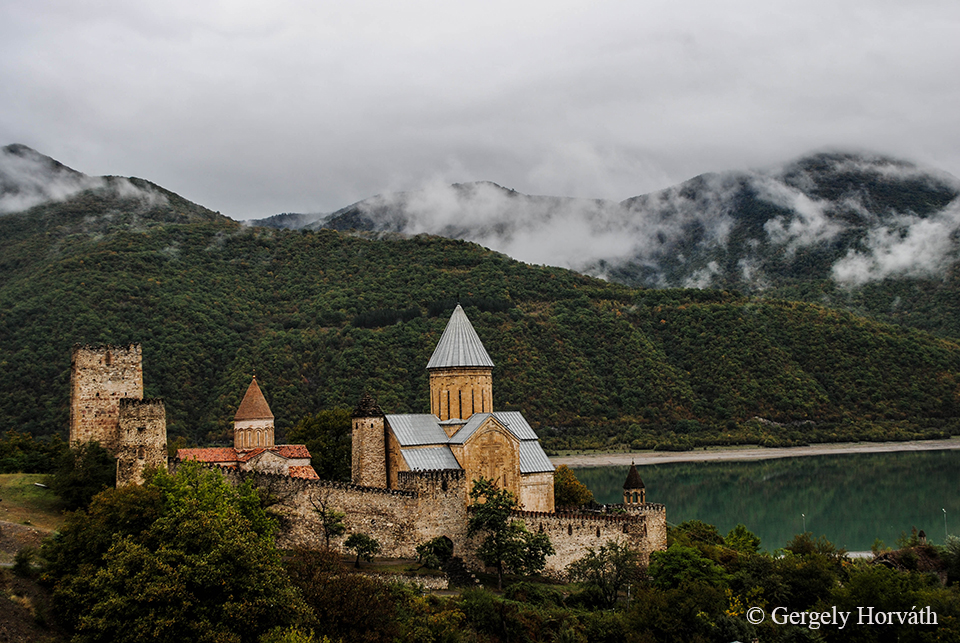Jerevánba kissé feldúlt állapotban sikerült megérkeznünk, ami csak részben volt köszönhető a több, mint 6 órás buszozásnak. Ez, valljuk be, még akkor is nagy büntetés, ha az ember útitársait nem emelik ki a határon a sorból az egész csapatot másfél órás veszteglésre kényszerítve ezzel Grúzia és Örményország között. Viszont legalább alkalmunk volt kicsit kinyújtóztatni tagjainkat. Az ember naivan arra számítana ugyanis, hogy 300 km-es távon azért csak betervez a sofőr egy vagy optimális esetben kettő pihenőt, nem pedig lendületesen terjegetve, szigorú „Davaj, davaj!” kiáltásokkal igyekszik mindenki kedvét elvenni az anyagcsere-folyamatok folytatásának még csak gondolatától is. Gyanítom, ha nincs a határ, sofőrünk egyhuzamban letudta volna az egész utat, és a végén is csak nagy duzzogva kanyarodik be a Kilikia Buszállomásra. Mindezt betetézendő, szállásunkra egy óra keresgélés után találtunk rá, hála az internetes foglalás során (szerintem) helytelenül feltüntetett címnek. Szóval kicsit megtört bennünk valami, na.
We managed to arrive to Yerevan in a bit distressed state, what was just partly the outcome of the more than six hours of bus-ride. This, to be frank, a big punishment even if some of your co-travellers would not uphold by border guards forcing the whole group to wait one and a half hours at the Georgian-Armenian border. As it turned out though, this forced rest had some positive outcomes, as at least we had a chance to stretch our limbs. You’d think that the driver makes minimum one but optimally two stops during a 300 kms long travel rather than dynamically brandishing with his arms and yelling ’Davai, Davai!’discouraging everyone even thinking about to continuing metabolic processes. I suppose that if there were no border at all, our man would carry out the whole ride at once and at the very end stops pouting at the Kilikia Bus Station. On top of everything we found our hostel after one hour of intensive searching in the outskirts of the city, as the address was given wrong during the booking. So we lost our cool a bit.
Itt jegyezném meg, hogy a legendás Kaukázusi vendégszeretet és hihetetlen segítőkészség Örményországban csapott arcul minket igazán. Tényleg hihetetlen, de még közös nyelv teljes hiányában is mindenki a lehetőségeihez mért maximális mértékben megpróbált nekünk segíteni. Mikor magyarázza el Pesten kézzel-lábbal a pénzváltó, hogy melyik busszal kell eljutni oda, ahova akarsz? Vagy ajánlja fel a buszon utazó totál ismeretlen személy, hogy megfogja a táskádat, hogy ne kelljen görnyedezned, ha már egyszer nem jutott hely? Vagy szól hátra a buszsofőr, hogy itt kell leszállni? Ugye- hogy- ugye? Bárhova mentünk is az országban, csupa jó fej emberbe ütköztünk, akik mindent megtettek kényelmünk érdekében. Ez úton is köszönet és üdvözlet nekik! Örményországra is igaz egyébként, hogy oroszul gyakorlatilag mindenki tud, úgyhogy pár szó ismerete csodákat képes tenni, de rengetegen és kiválóan beszélnek angolul is, főleg a fiatalabb generáció tagjai.
However, I would like to note here that we experienced the legendary Caucasian hospitality in Armenia whit an overwhelming intensity from the very beginning. It’s truly amazing that everybody tried to help us as far as possible and in some cases even the lack of the common language wasn’t a problem at all. Just ask yourself, when would the guy at the exchange office tell you, mostly signing with his hands, which bus you need to take? Or when would a total stranger on the bus offer you that he/she will hold your bag, as you have no space left to hold your belongings comfortably? Or when would the bus driver call you from the back of the vehicle that we are at the exact stop you’re looking for? Honestly, I never met such a hospitality in Europe. Wherever did we go across the country, we met super nice and cool people, who did everything to make us feel comfortable. Many thanks and cheers to them! By the way, as in the whole region the most useful language in Armenia is Russian too. Literally everybody understands and speaks Russian on some level. Learning a few phrases will open many gates, however, many young people speaks very well English too.
A hat órás utat persze mivel mással lehetne elütni, mint fotózással, amire az Örmény-felföld rengeteg okot szolgáltat, lássunk is párat:
What could you do during a six hours bus-ride than taking pictures? The Armenian Highland offers perfect themes let’s see a few:

Az örmény népirtás emlékezete elevenebb, mint valaha és az áldozatoknak szentelt emlékhelyek szinte mindenhol megtalálhatóak.
The memory of Armenian genocide is more vivid than ever and memorials could occur anywhere.



Személyes benyomásom az, hogy az örmény főváros minden porcikájából modernség árad, bár kevésbé karakteres, mint Tbiliszi. A belvárosban járva – és eltekintve az örmény betűs feliratoktól – szinte már egy nyugat európai nagyvárosban érezhetjük magunkat. Ez azért is lehetséges, mert bár a Jereván közvetlen elődjét képező erődöt Kr.e. 782-ben alapították (Rómánál 29 évvel öregebb!) a szovjet időkig nem volt jelentős település, úgyhogy a 20. században fejlesztették fel igazán.
My personal impression is that Yerevan is a very modern and vibrating city, however, less characteristic than Tbilisi. Walking around the downtown you might even think that you are in a western European city, aside from the unique Armenian script of course. This mainly comes from the fact that Yerevan was a provincial town till the early 20th century and in its current form it was built mainly during the soviet era. This is a bit controversial though considering that Yerevan is a REALLY ancient city since the fortress which was the predecessor of the city was funded in 782 BC. This means that Yerevan is 29 years older than Rome. Quite impressive I think.

A város alapításának emlékére állított tábla.
Plaque commemorating the foundation of the city.

Jereván címere.
Coat of arms of Yerevan.
Nem csak Jereván, hanem Örményország és az örmény kultúra is igen ősi gyökerekkel rendelkezik. Ezt mi sem bizonyít jobban, mint hogy amikor 1918-ban Örményország elnyerte függetlenségét az Orosz Birodalomtól, a fővárossá kikiáltott Jereván immár 13. volt ebben a sorban. Az akkor 30 ezres kisváros a 20. sz. intenzív városfejlesztési munkálatainak köszönhetően ma már bő 1 millió lakossal rendelkezik. Ez Örményország lakosságának 1/3-a!
Not only Yerevan has ancient roots but Armenia and the Armenian culture as well. When the First Armenian Republic became independent from the Russian Empire in 1918 Yerevan was chosen to be the 13th capital of the Armenian nation. Back then the town had 30.000 inhabitants but through the intensive urbanization and development during the 20th century the city has now more than 1 million inhabitants. This is one-third of the population of Armenia!

A köztársaság tere az 1920-as években épült a város szívében, de végső formáját csak 1958-ban nyerte el. Ma itt található többek között a Nemzeti Galéria, számos minisztériumi épület, és az Örmény Kormány Központi épülete (itt felül). Az épületeket, Örményország egész területére jellemző módon, vulkáni tufából faragott kövekből emelték. Fehéres-rózsás színűk miatt Jerevánt gyakran „Rózsás városnak” vagy „Rózsaszín városnak” becézik.
In the heart of the city the Republic Square was built in the 1920s but it was finished only in 1958. Here you find the National Gallery, buildings of many ministries and the Government House of Armenia (on the picture). The buildings, as you can notice all across the country, are built of volcanic tufa. The white-pink colour of these bricks gave Yerevan the nicknames ‘Rosy city’ or ‘Pink city’.




Nemzeti Galéria.
National Gallery.


Az Örmény Opera épülete.
The Armenian Opera House.

Arno Babadzsanjan zongorista szobra.
Statue of pianist Arno Babajanian.

A város ottjártunkkor ünnepelhette 2797. születésnapját.
The city celebrated its 2797th birthday at the time we were there.

A Központi Piac bejárata.
Entrance of the Central Market/ Prospect Mall.

Majr Hajasztan (Örményország Anyácska) a város feletti dombon, a Győzelem Parkban található. Grúz párjához hasonlóan a nemzet megtestesítője, ám sokkal nagyobb, mivel talapzattal együtt 51 m magas. 1967-ben állították, a korábban itt található Sztálin szobor helyére. Ma itt található az Örmény Hadtörténeti Múzeum.
Mayr Hayastan (Mother Armenia) guards over the city at the Victory Park. Like its Georgian counterpart this statue is the female personalization of Armenia, however, it is much bigger as together with the pedestal it’s 51 m tall. This statue was erected in 1967 replacing the statue of Stalin formerly stood here. Now the Armenian Military Museum can be found in the pedestal.

Alexander Tamanian szobra. Az orosz születésű építész munkásságához köthető a modern városkép kialakulása.
Statue of Alexander Tamanian, the Russian born Armenian architect who designed most of the modern Yerevan.

A város talán legnagyobb nevezetessége a Kaszkád. Ez a tulajdonképpeni lépcsősor 1971-80 között épült a város egy dombjának oldalába. A 2000-es évek során végzett felújítási munkálatok nyomán ma nyílt kiállítótér és múzeum. Az épület belsejében működik a Gerard Cafesjian Művészeti Központ, emléket állítva az örmény-amerikai üzletembernek, aki a felújtást finanszírozta.
Maybe the biggest landmark of the city is the Cascade. This stairway was built between 1971 and 1980 on one of the hillsides of the city. It was renovated and expanded during the 2000s so now it is an open museum and exhibition centre. Inside of the building the Cafesjian Centre of Arts is situated memorised to Gerard Cafesjian, an American-Armenian businessman who financed the reconstruction works.







A Kaszkád tetejéről jó kilátás nyílik a városra és környékére. Igaz, hogy a képen a légköri viszonyok nem igazán kedvezőek, de azért a háttérben felsejlik az örmény nemzeti büszkeség non plus ultrája, az örmény címerben is szereplő és számunkra a bibliából jól ismert hegy, az Ararát (örményül Maszisz).
From the top of the Cascade you have a good view on the city and it’s surroundings. The weather wasn’t the best here, but in the background you might see the mountain which is represented in the Armenian coat of arms and the Bible as well. The non plus ultra of the Armenian national pride and the most important symbol of the nation: Mt. Ararat (Masis in Armenian).

Itt már teljes valójában látható az 5137 m magas csúcs, ami az örmény hagyományok szerint az istenek lakhelye. Valójában egy vulkánról van szó, ami nem is olyan rég még aktivitás jeleit mutatta. Több kilométeres körzetben nincs olyan hely, ahonnan ne látnánk. Az már a kis népek történelemhez való viszonyát tükrözi, hogy a határ túloldalán, Törökországban található. Azt hiszem, ezzel együtt tudunk érezni.
Here you can see the 5.137 m high Ararat better. According to the Armenian legends, this is the home of the gods. In fact it is a stratovolcano with recent historic activity. You cannot find any spot in several miles radius where you can’t see it. Sadly, the history was never gentle or fair with small nations so today it is located in Turkish territory. We could feel sympathy about that I think.

Kilátás szállásunk ablakából.
View from our hostel window.
Végezetül egy fontos információ, amit Sopron lakóival szeretnék megosztani, mert valószínűleg őket is ugyanúgy marja a kíváncsiság, mint ahogy engem is kínzott: Van-e Sopronról elnevezett lakótelep az örmény fővárosban? Ha ezt nem is, de egy “Shopron” nevű utcát azért sikerült találnom a külvárosban. Azt hiszem, ezt elfogadhatjuk, nyugtázva, hogy a testvérvárosi viszony azért elhibázott politikai döntések ellenére valamilyen formában még mindig éldegél.
At the end I would like to share a very important finding with the people of my favourite Hungarian town, Sopron. I think they are as curios about this vital question as I was: Is there anything named after Sopron in the Armenian capital? Well, there is a ’Shopron’ street at the outskirts. I think it’s close enough. Despite all bad political decisions, the memories of the former partnership between the two settlements still can be found.
Egy röpke ecsmiadzini kitérő után Jerevánból utunk Dél-Örményországba, Szjunik tartományba vezetett, ahol a helyi kultúra legkorábbi hagyatékaival, az Ugtazar sziklarajzaival és az "örmény Stonehenge-dzsel", a Zorac Karerrel ismerkedtünk meg.
After a short visit to Etchmiadzin our travel continued to Syunik province in southern Armenia, where we found the oldest representers of local culture: the petroglyphs of Ughtasar and Zorats Karer the 'Armenian Stonehenge'

